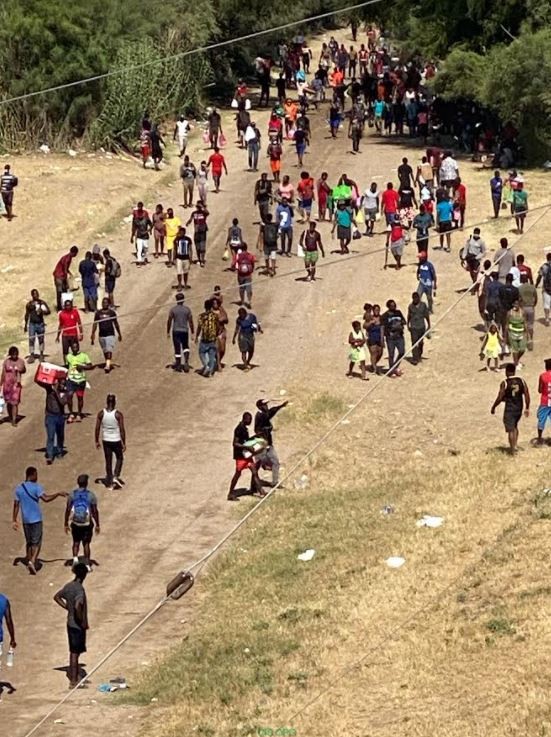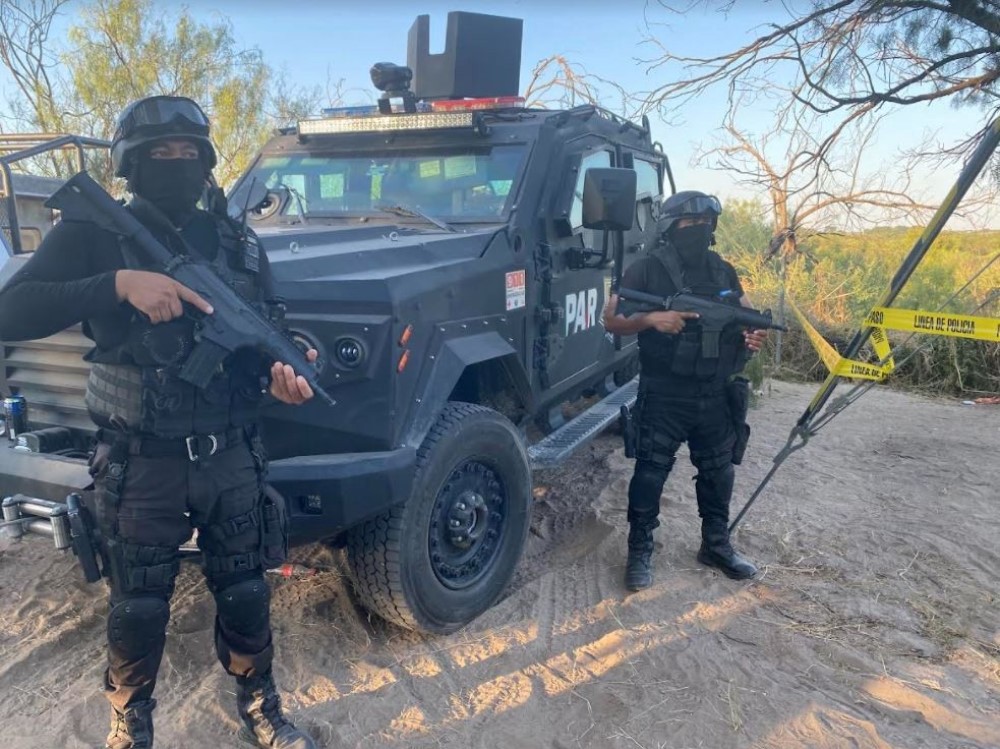
The September 12–24 migrant camp crisis in Del Rio displayed two lessons very much worth unpacking from the White House response. Two main actionable takeaways from Del Rio that the White House, Congress, and U.S. media should know, study and apply to significantly temper the crisis that birthed Del Rio
See all of Bensman’s Del Rio migrant camp coverage here
Link to all Bensman media interviews about the camp here
By Todd Bensman as published September 30, 2021by The Federalist
DEL RIO, Texas — The migrant encampment under the international bridge here is liquidated, the 15,000 mostly Haitian illegal migrants who had pooled under it gone to different futures (most paroled into the United States but others flown to Haiti). Bulldozers have erased all trace evidence that anything of much note ever happened here.
Except that much of note did happen during the September 12–24 migrant camp crisis in Del Rio, including two lessons very much worth unpacking from the White House response, which saw this as a political canker sore and therefore swiftly ended it. If retained and refined, these two moves hold the power to prevent a recurrence of new such camps but, perhaps more importantly, to douse the far wider mass migration crisis from which this one spawned.
The Del Rio camp — with its 15,000 temporary inhabitants and all the media attention it attracted — needs to be viewed in proper context as a relatively minor solar flare in a far wider crisis that brings in 50,000 immigrants every single week (on track for 1.7 million for FY2021) across hundreds of miles of America’s southern border, yet weirdly attracts far less media attention.
The Del Rio camp, however shiny a bauble it was for network news cameras, amounts to a typical Texas breakfast hour on any given day, so vast is the crisis that spawned their riverbank shantytown. Two main actionable takeaways from Del Rio that the White House, Congress, and U.S. media should know, study and apply to significantly temper the crisis that birthed Del Rio, are:
- Rolling out repatriation flights to home nations as a credible threat proved to be a magic pill for sharply reducing mass illegal immigration and should be retained and expanded to the rest of the border and other nationalities now.
- Del Rio revealed a deeply troubled U.S.-Mexico diplomatic relationship that relied on carrots but requires a radically different American approach that involves the stick, which proved miraculously effective during September.
A Clearly Dysfunctional U.S.-Mexico Relationship
The Mexican government caused the Del Rio camp to form, the Center for Immigration Studies has concluded from interviews with immigrants in Ciudad Acuna, Mexico, just across from Del Rio. The camp’s formation reveals that Mexico neither respects nor fears the Biden administration’s carrots-based approach to diplomacy, and feels free enough of potential consequences to casually renege on diplomatic bargains.
In this case, the Mexican national interest in setting loose thousands of migrants toward the American border on September 12 seemed especially trivial for trashing a diplomatic agreement with America: creating a nicer environment for Mexico’s cherished El Grito national independence celebrations the week of September 16.

The Del Rio camp from the international bridge September 2021. Photo by Todd Bensman.
Consider what CIS learned from interviews with dozens of the Del Rio camp’s inhabitants against the backdrop of Joe Biden’s election and opening presidential moves on immigration policy.
By February 2021, it became clear that Biden’s first immigration policy actions — eliminating most interior deportations, getting rid of President Trump’s instant expulsion practices, and fast-track legalizing family groups and children who illegally crossed the border, for starters — had spurred a mass migration event. So Biden’s State Department went to Mexico and cut quid pro quo deals that asked Mexico to slow this migration down.
The administration offered Mexico and Central American nations billions in aid, for instance, as well as coronavirus vaccines. In return, Mexico agreed to a Biden request to keep a Trump-era Mexican National Guard deployment of 9,000 on its southern border with Guatemala.
Specifically, the troops would enforce a Mexican plan to require that arriving immigrants secure Mexican asylum or other legal permissions as a precondition to travel out of the country’s southernmost provinces. But approvals were slow-rolled, often for months.
Thousands backed up in and around the southern Chiapas State city of Tapachula — more than 20,000 Haitians, for instance, applied for Mexican asylum through July. Those who couldn’t hire expensive smugglers to end-run the new requirements were made to wait months for approvals that never seemed to come.
By the first week of September, frustration boiled into violent clashes as mostly Haitian immigrants formed caravans and tried to break through the National Guard. They and guard formations repeatedly clashed in southern Mexican towns and cities as Mexico tried to keep its word to the United States. The Mexican government forces were still battering the caravans for days by the second week of September, clubbing men, women, and children into vehicles for transport back south.
But then, on September 12, the Mexican government suddenly caved, according to migrants who later reached the Del Rio camp. Government officials in Mexico’s deep south had told them all: never mind the papers. They gave the Haitians a three-day grace period to clear out of Tapachula. An exodus of thousands promptly moved northward that day, mostly by bus — toward Del Rio, Texas, a day or two ride away.
The reason local officials gave the immigrants for this gift was the onset of El Grito. Mexico has never publicly confirmed this but it seems likely that the government wanted to grant the immigrant-weary people of southern Mexican states a reprieve from violent clashes that seemed poised to ruin the coming weeklong festivities of parades and cook-outs.
“The government allowed us to leave,” one of those Haitian migrants, who gave his name as Kelson, told CIS. He was with a small group that had just gotten off a bus that departed from Tapachula. The government decision to let everyone leave permit-less was very sudden. “We don’t know why, but a lot of the offices were going to be closing for the holiday.”
He said thousands of Tapachula migrants left town as soon as they could and headed for Ciudad Acuna and Del Rio.
Why Did They Go to Del Rio?
Another Haitian who wrote his name as Donley Vainqueur said he and his family were forced to wait in Tapachula for months, applying for what he termed “passports” to the rest of Mexico. He said every day he would go to check on the status of his application. Then, all of a sudden one day when he went to check, “They [Mexican immigration officials in Tapachula] said, ‘Okay, you can cross for three days because of the days of festivities.’”
Why did they go to Del Rio and not other, more trammeled parts of the Texas-Mexico border? Because it’s free to cross the Rio Grande here, and safe; Mexican cartels in the region are largely uninvolved in human smuggling, according to prior CIS reporting in March 2021 from Del Rio and across the river in Ciudad Acuna.
True to El Grito, Mexican authorities in Ciudad Acuna at the main Rio Grande crossing into the camp told CIS they were under orders not to interfere with the Haitians pouring over the Rio Grande into Del Rio. State police and National Guard could be seen passively observing as hundreds of migrants moved back and forth over the river within feet of them. One Coahuila police officer said they were stationed there to keep order against crime only.
By mid-week of the Del Rio camp crisis-within-a-crisis, however, the Mexican government was somehow made to realize its diplomatic affront.

Coahuila State Police with an armored vehicle blocking migrants from the river crossing to Del Rio. Photo by Todd Bensman.
Mexican Cooperation Is Crucial
Mexico’s central government ordered a sharp about-face with a series of tough enforcement moves, shutting off almost entirely the incoming spigot of migrants, that testify to the criticality of Mexican involvement in U.S. border security when that government is made to care.
After days of purposefully letting all migrants cross into Del Rio, the State Police manning the main crossing this time had that entry point roped off and completely vacant under new orders, the officers told CIS: let no one through.
Not that any migrants wanted to go through by then, because the Biden administration had just begun shipping the migrants back to Haiti aboard Immigration and Customs Enforcement air flights. This tactic, politically unpalatable to the Biden administration but reluctantly acknowledged as highly effective, sent thousands of the Del Rio camp migrants fleeing back into Mexico, no small few boarding southbound commercial buses, on just the chance that they might end up on an ICE flight, all who were interviewed told CIS in Acuna.
But even had they wanted to still cross at Del Rio or elsewhere in the area, they would have found this very difficult in Mexico with its turn-on-a-dime border policies.
In Ciudad Acuna, Mexican National Guard and immigration officials began running systematic raids on all hotels, rousting immigrants and putting them on daily flights out of the Acuna airport back, at least, to the southern Mexican provinces from which they came, members of the guard told CIS. Some credible media reports had it that Mexico would begin its own repatriation flights to Haiti. Meanwhile, National Guard roadblocks went up in central Mexico to turn around northbound buses carrying migrants.

A Mexican National Guard group during a raid on a Ciudad Acuna hotel rousting immigrants. Photo by Todd Bensman.
Mexican National Guard apprehend a Cameroonian migrant they flushed from a hotel room in Ciudad Acuna and who leaped from a second-floor balcony, shattering his leg. Photo by Todd Bensman.
The Lesson to Learn
Did the Biden State Department make some angry and demanding phone calls that included threats? That isn’t known for certain, but it undoubtedly happened. Whatever the Americans told Mexico to do, it did. And this amply demonstrates the sheer power that a more robust American approach to diplomacy with Mexico can have on mass illegal immigration.
None of this should surprise. When he was president, Trump did not rely on paying aid or giving medicines to the Mexican government to do his bidding; he threatened economically destructive trade tariffs on all Mexican exports if Mexico did cooperate with his policies and demands to slow migration on its southern border.
That’s why Mexico originally deployed its troops on the Guatemala border and at the northern border to block illegal immigration and deport most southward if they did not apply for asylum. And it worked for all of the time those threats remained on the table, as CIS reported from Tapachula in January 2020.
It’s a safe bet that Mexico would never have considered unleashing thousands of migrants for El Grito had President Trump been in office with his stick-based diplomacy about the border.
While it’s unclear whether the Biden State Department threatened Mexico mid-week to get its side of the camp under control, the key takeaway from the Del Rio experience is that a different American approach, perhaps one that includes the stick, would undoubtedly go far to eliminate the broader mass migration crisis along all of the U.S. southern border. That’s especially in conjunction with another important lesson learned from Del Rio.
The Repatriation Flights
Perhaps no tactic proved more impactful in ending the Del Rio camp than was the Biden administration’s politically unpalatable resort to the Trump-era policy of repatriation flights to Haiti. That’s especially when done in conjunction with Mexico’s (probably forced) repatriation flights, hotel raids, border closures across from Del Rio, and removal operations of other varieties mid-way through the camp crisis it directly caused for El Grito.
Some estimates suggest that as many as 5,000 of the Del Rio camp’s original residents fled back into Mexico. Migrants leaving on southbound buses and in a public park on the Mexican side across from Del Rio told CIS they were leaving in abject fear of the deportation flights.
Only about 2,500 of the 15,000 were flown to Haiti, but no matter. Those 2,500 texted and emailed warnings back to those still in the camp: Leave! Get out! Don’t go near the ICE buses! They’re going to deport you!
Wholesale repatriation by air did not seem necessary; just a small percentage seemed enough to send Haitians fleeing, dozens of migrants told CIS in Ciudad Acuna, to which they initially fled. Asked why one was going back to Tapachula, one typical migrant who’d fled Del Rio answered, with a touch of anger: “Because Biden said all Haitians coming will be returned to their country. We spent much money to come here. Much, much, much money. And we get nothing now. This is very sad for me.”
Of course, the Trump administration succeeded in reducing a mass migration episode that erupted in early 2019, in large part, by using air repatriation to home countries too. In 2019, for instance, the Trump administration deported 50,000 Guatemalan immigrants in a bid to increase the risk to others that their smuggling fees and effort would not pay off. Many stopped trying to come, unwilling to waste smuggling fee investments.
It remains unclear how long the Biden administration will use the repatriation flight option. Other important questions about it remain unanswered too, such as whether its use will be extended to the rest of the border or apply to the many other nationalities crossing the southern border in large numbers.
We Could Secure the Border If Biden Wanted
The important takeaway was that, even in this one limited experimental use of repatriation flights, it proved highly impactful as a real deterrent that stopped entry into the camp and then reduced the camp’s population almost single-handedly. Air repatriation was the single most effective tool the administration brought to bear in liquidating the camp. This is very much worth knowing because, if ever applied border-wide to a greater number of nationalities, the broader border crisis might be significantly attenuated.
Another key particle of related information worth knowing is how its use plays in migrants’ decision-making. Many of those who fled the Del Rio camp said they planned to disappear into Mexico City or Monterrey or Tapachula to get their Mexican asylum, work, and bide their time until one thing happens, and one thing only: the Biden administration stops the repatriation flights. Then they will return to cross the U.S. border.
This article is republished, with permission, from the Center for Immigration Studies.